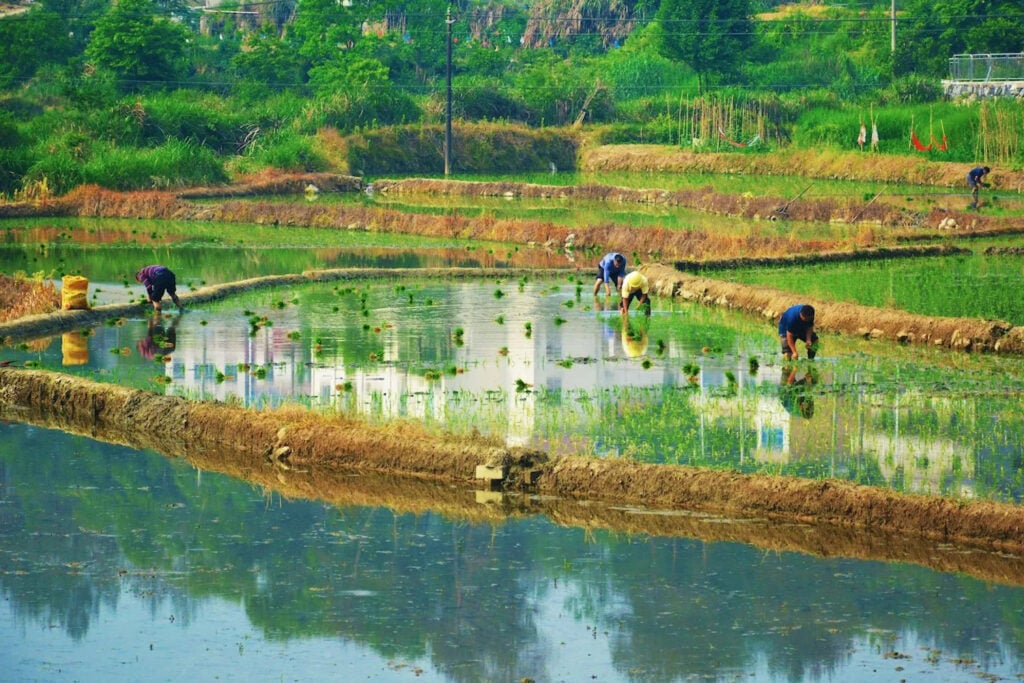This story was originally published Gristor. Sign up for Grist Weekly Bulletin here.
Yangtze River Delta, a popular region in southern China, a popular region for the production of widespread rice, farmers grow slender green branches. Soak up in muddy plants for months, without reaching a few feet tall and golden brown. Throughout the rows of submarines, farmers share a stable water supply and water supply area where farmers caused from nearby channels.
This traditional experience of flood padies to cultivate a thirsty product is almost as old as the location of almost ancient grain. A thousand years later, the agricultural method is dominated by the world’s low-field field areas, the world cultivation experience from Vietnam’s slippery terraces.
As the planet is heated, this popular process is becoming increasingly dangerous for millions of people who eat grain regularly research Tuesday was published in Lancet Planetary Health magazine. After drinking drinking water, researchers say the rice is the world’s second major source of diet, and the climate change increases the amount of highly poisonous chemicals. If nothing is done to produce the majority of the majority of the world, they think that the authorities, the authors, rice-heavy communities will continue to oppose cancer and disease risks by 2050.
« Our results are very terrible, » Donming Wang, Environmentally Doctoral Academy of Sciences, China Academy of Sciences, China Academy of Sciences, which is in the Institute of Land Sciences. « It’s a disaster … and the wakeful call. »
In 2014, Wang and international environment, plant and public health scientists began to work on a research project, they started working on a research project. Walking through rice paddies along the Yangtze Delta, in 2050 they tried to learn how the temperature and level of the atmosphere CO2 will interact with the land Arsenic and the planted rice plants. Past research was a problem in the carcodogen’s rice plants, but they wanted to know the more problems in the world of warming. The team did not just look at any rice, but some of the most produced and consumed grains in the world.
Although there is About 40,000 species of rice On the planet, they tend to join three categories for the length of the grain. Short grain rice or glue that is often used in sushi; Prolonged grains that include aromatic species such as Basmati and Jasmine; and the average grain or inclined rice served as a basic food. Of them, short-middle Japonica and long grain are present Cultivated rice two main subspecies Eaten throughout asia. Wang’s research modeled 28 types of Japonica and hybrid rice strains for seven of 28 species, India’s highest rice strains: Bangladesh, China, India, India, Myanmar, Philippines and Vietnam. India is between Vietnam and China Group eight nations lead the rest of the world in exports of rice.
After a decade, the researchers encouraged the growth of the higher temperature and CO2 compound, which increase the root growth of the rice plants, which increase the plants. They believe that these changes in climate in land chemistry, the changes related to the climate preference, can be imposed easier. Carbon-dioxide enriched products hit a more stimulating part of Arsenic, including more atmospheric carbon and part of the land.
How much root growth can be a source of food for soil bacteria, which is more carbon in the land, the temperature of warming. When the land is immersed in a rice paddy, oxygen is running out of oxygen, soil bacteria causes further to create energy to create energy. The end result is built in more arsenics in the rice paddy and more root for grain to develop it.
This arsenal-collection effects associated with root growth and carbon seize, unaffiliated Corey Lesk with paper, postdoctoral climate and product researcher Corey Lesk is a paradoxical surprise for Corey Lesk. Paradox, Lesk, both of these results are discussed as potential benefits for rice product under climate change. « More root rice can be more drought-resistant and can increase productivity in cheaper carbon, generally, » he said. « However, the additional arsenic collection can be difficult to implement the benefits of health from this product Boost. »
Arsenic comes in many different forms. Notorly Toxic, Inorganic Arsenic – Non-Carbon Element Connections – World Health Organization classify as a « confirmed carcinogenic » and « the most important chemical pollutant in drinking water in the world. » There are such arsenic forms Usually more toxic It can allow people to interact with molecules that they are less stable than organic colleagues and exposure to arsenic. Chronic exposure is combined between lungs, bladder and skin cancers, as well as heart disease, diabetes, negative pregnancy, neurodevelopmental issues and weakened immunity issues, other health effects.
Scientists and public and health experts are known for years, the presence of arsenic in food is a mounting threat, but the diet was considered less than risk than polluted groundwater. Thus, policy measures went slowly to reduce the risk. For example, several existing standards applied by the European Union and China are considered inappropriate and in a compatible and great extent. No country has created officially determined rules for organic arsenic exposure to food. (Food and Drug Management was established in the United States A 100-part level of movement of a billion in the baby’s rice grainBut this recommendation for manufacturers is not an adjustment applied in Arsenic in rice or any other meals.)
Wang hopes to see this change. Today, the level of non-organic arensics in the recommended standards of China is « worst in the worst case », forecasting the « worst case » to the 2050 « worst » climatic scenario (3.6 degrees Fahrenheit) and the other in the CO2 levels that increase the other 200 parts for a millionThe level of inorganic arsenos in the learned rice varieties is projected to increase by 44 percent. This means that more than half of the rice samples are offered China’s ready-made limits, paddy rice in 200 parts per billion for inorganic arsenic, compared to 13.4 million cancers related to rice-based arsenic exposure.
Because these health risks will face the best health cargo calculated on the basis of body weight, babies and young children. According to researchers, in particular, in the opinion of babies and researchers, rice can face consumption.
« You talk about a product bar that feeds billions and more carbon dioxide and hot temperature, the amount of arsenic in this staple, a very large word, a very large word, to explore the amount of great word, » Climate change and public health at Columbia University
But everyone should suddenly stop eating the rice, he added. Although the team finds the amount of inorganic arsenic in the rice, it is higher than many other plants, still completely low. The key is how much a person enjoys. If you have one of the largest parts of the world consuming rice a week, it can contact you in this teah load, but more rarely, Ziska said that the inorganic Arsenic will not be a « big thing ».
In this way, the forecasts of research can also increase the existing global and social unequacy, because it is one of the most eager grains of the planet, because it is the most convenient for a long time.
Better land management and planting in season to minimize the tendency to prevent global greenhouse gas emissions – Ziska « Ziska » to prevent the tendency of rice and sprinkles.
Irrigation methods such as alternative wetting and drying, paddy areas can be used primarily to reduce this growing health risks permissible and Great methane footprint of grain. In a global scale, rice production is roughly rough 8 percent of all methane emissions from human activity – The ideal conditions for flood paddy areas methane spreads bacteria.
« This is the end of the world, rising sea levels, 10 storms, 10 storms, which consists of 10 storms, it is 10 storms, » he said. « But I will honestly say that it will have the greatest impact in mankind, for we all eat. »
This post appeared first Gristor horse https://grist.org/food-and-land. Grist is a non-profit media organization dedicated to explaining a climate solution and a fair future stories. Learn more Grist.org













Leave a Reply